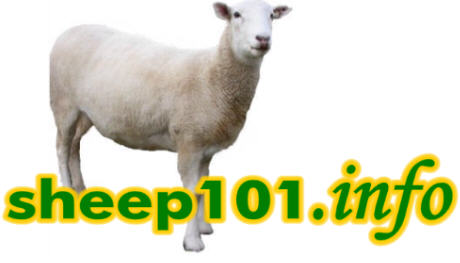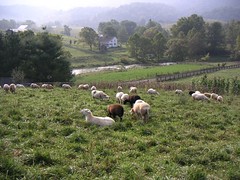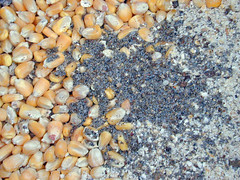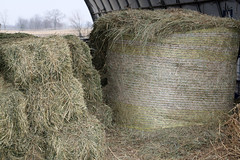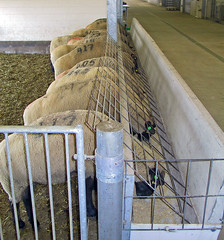What's for dinner?
Grass, clover, and forbs
Mostly sheep eat grass, legumes, forbs, and other pasture plants.
They especially love forbs. In fact, it is usually their first choice of
food in a pasture. A forb is a broad-leaf plant other than grass.
It is a flowering plant. Forbs are often very nutritious. As compared
to cattle, sheep eat a greater variety of plants and select a
more nutritious diet, though less so than goats.
Grazing time
Sheep will graze for an average of seven hours per day, mostly
in the hours around dawn and in the late afternoon, near sunset.
When supplements are fed to pastured sheep, it is best to feed them in the middle
of the day so that normal grazing patterns are not disrupted.
Different plants
Sheep in different geographic areas eat different plants. Tropical
forages are usually not as nutritious as those that grow in temperate
climates. Either protein or energy may be the limiting nutrient in a forage diet.
All forages are more nutritious if they are eaten in a vegetative
state.
Pasture (land) requirements
The amount of pasture or range land that it takes to feed a sheep
depends upon the quality of the land (soil), the amount and distribution
of rainfall, the species of forage, and the management of the pasture.
In dry climates,
one acre (or hectare) of pasture or rangeland cannot feed as many
sheep as an acre of pasture in a moist climate. An acre of pasture
in the wet season (spring and fall) can support more sheep
than an acre in the dry season (usually summer).
Plants do not grow at the same rate all year round. Some plants do most of their growing in cool weather (spring, fall), whereas others produce the most growth during the warmer months. If different forage species are planted, it is possible to provide year-round grazing for sheep, with snow cover being the only limiting factor.
Reproductive rates and lamb growth rates are lower in arid climates
than high-rainfall areas that grow more plentiful forage. As a
result, wool production tends to be of greater importance in arid and semi-arid
environments, as it takes less nutrition to grow good quality
wool than to produce milk and raise lambs. A farmer may be able
to graze ten sheep on one acre of improved pasture in Maryland,
whereas one sheep could require ten acres of native range in West
Texas.
Stored feed
When fresh forage is not available or it is inadequate to meet their dietary requirements, sheep are usually fed stored
or harvested feeds: hay, silage, balage, green chop, or crop by-products. Hay is
grass that has been mowed (cut) and cured (dried) for use as livestock
feed.
Silage (short for ensilage) or haylage is green forage that
has been fermented and stored in a silo or other system that keeps
air out. Moldy silage can cause listeriosis or "circling disease" in sheep. The pieces
should be chopped smaller for sheep as compared to cattle.
Sometimes, pasture plants are cut, chopped, and brought to the
sheep. Fresh harvested forage is called green chop. This "cut-and-carry"
system of feeding is common in developing countries, where labor is not a limiting factor. Many types of plants can be cut, chopped, if necessary, and fed to sheep.
Supplementation
Grain is often fed to sheep with higher nutritional needs, such
as pregnant ewes during late gestation, ewes nursing two or more
lambs, and lambs with the genetic potential for rapid growth.
Grain is the seed part of cereal crops such as corn, barley, wheat,
and oats. It is not "unnatural" for sheep to eat grain. They have always eaten the seeds of plants. There are microorganisms in the rumen which can digest the starch in grain.
A protein source, such as soybean meal or cottonseed meal is usually
added to the grain ration, along with vitamins and minerals to
make a 100 percent nutritionally-balanced feed. Unbalanced grain
rations can lead to a variety of health concerns.
Sheep love the taste of grain and can experience digestive problems if they eat too
much grain too fast. Grain consumption needs to be regulated,
introduced slowly, and gradually increased in the diet. At the same time, any dietary change can disrupt healthy digestion.
Ruminants, such as sheep, should always
have some roughage (fibrous feed) in their diets. At least a pound per day for
sheep is usually recommended. Producers in many parts of the world cannot afford to feed
grain to their livestock. Whereas in some parts of the U.S. and
in some years, grain is a more economical source of nutrients that
forage.
By-products
By-products from crop production and food processing can also
be fed to sheep. This is another advantage of ruminant livestock: they can be fed products that would otherwise go to waste and/or require costly disposal. Examples of by-product feeds include soybean hulls, peanut hulls,
corn gluten feed, wheat middlings, and whole cottonseed. Sheep can also be fed pumpkins, apples, onion, and other leftover (or cull) foods.
With more corn being used in the production
of ethanol, distiller's grains are becoming a more popular (and more economical) feedstuff
for sheep and other livestock. Distiller's grains are the solids left after ethanol is made. They are also a by-product of the brewing industry. Distiller's grains can be fed wet or dry, but are usually fed dry. Distiller's grains can contain high levels of phosphorus and sulfur, so their inclusion in sheep and lamb diets is usually limited to a certain amount or percentage.
Learn more about what
sheep eat =>
